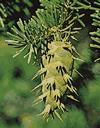- Douglas fir
-
a coniferous tree, Pseudotsuga menziesii, of western North America, often more than 200 ft. (60 m) high, having reddish-brown bark, flattened needles, and narrow, light-brown cones, and yielding a strong, durable timber: the state tree of Oregon. Also called Douglas pine, Douglas spruce, Oregon fir, Oregon pine.[1855-60; named after David Douglas (1798-1834), Scottish botanist and traveler in America]
* * *
Any of about six species of coniferous evergreen timber trees (see conifer) that make up the genus Pseudotsuga, in the pine family, native to western North America and eastern Asia.Long, flat, spirally arranged yellow-or blue-green needles grow directly from the branch. The North American tree commonly called Douglas fir is P. menziesii (sometimes P. douglasii). Douglas firs may grow to 250 ft (75 m) tall and 8 ft (2.4 m) in diameter. One of the best timber trees in North America, it is also a popular ornamental and Christmas tree and is used for reforestation along the Pacific Coast. Cone of a Douglas fir (Pseudotsuga menziesii )Grant Heilman
Cone of a Douglas fir (Pseudotsuga menziesii )Grant Heilman* * *
▪ treeany of about six species of coniferous evergreen timber trees comprising the genus Pseudotsuga of the family Pinaceae, native to western North America and eastern Asia. A Douglas fir has long, flat, spirally arranged needles that grow directly from the branch. Each yellow- or blue-green needle has a short stalk at the base and a grooved upper surface. Winter buds are brown, shiny, and pointed. The hanging, oblong cones have three-pointed bracts (outer cone scales). Cones mature in one season and retain their scales when they fall.The North American tree commonly known as Douglas fir is P. menziesii (P. douglasii by some authorities). It has several forms, one with reflexed bracts, that sometimes are considered to be separate species. Douglas fir may grow to 75 m (250 feet) tall and 2.4 m in diameter. It is one of the best timber trees in North America, as well as a popular ornamental and Christmas tree, and is used for reforestation along the Pacific Coast. The first seeds are produced at about 25 years, with large crops every 5 to 7 years. The bigcone Douglas fir (P. macrocarpa), a smaller species important only for erosion control, bears cones 10 to 15 cm (about 4 to 6 inches) long.* * *
Universalium. 2010.
